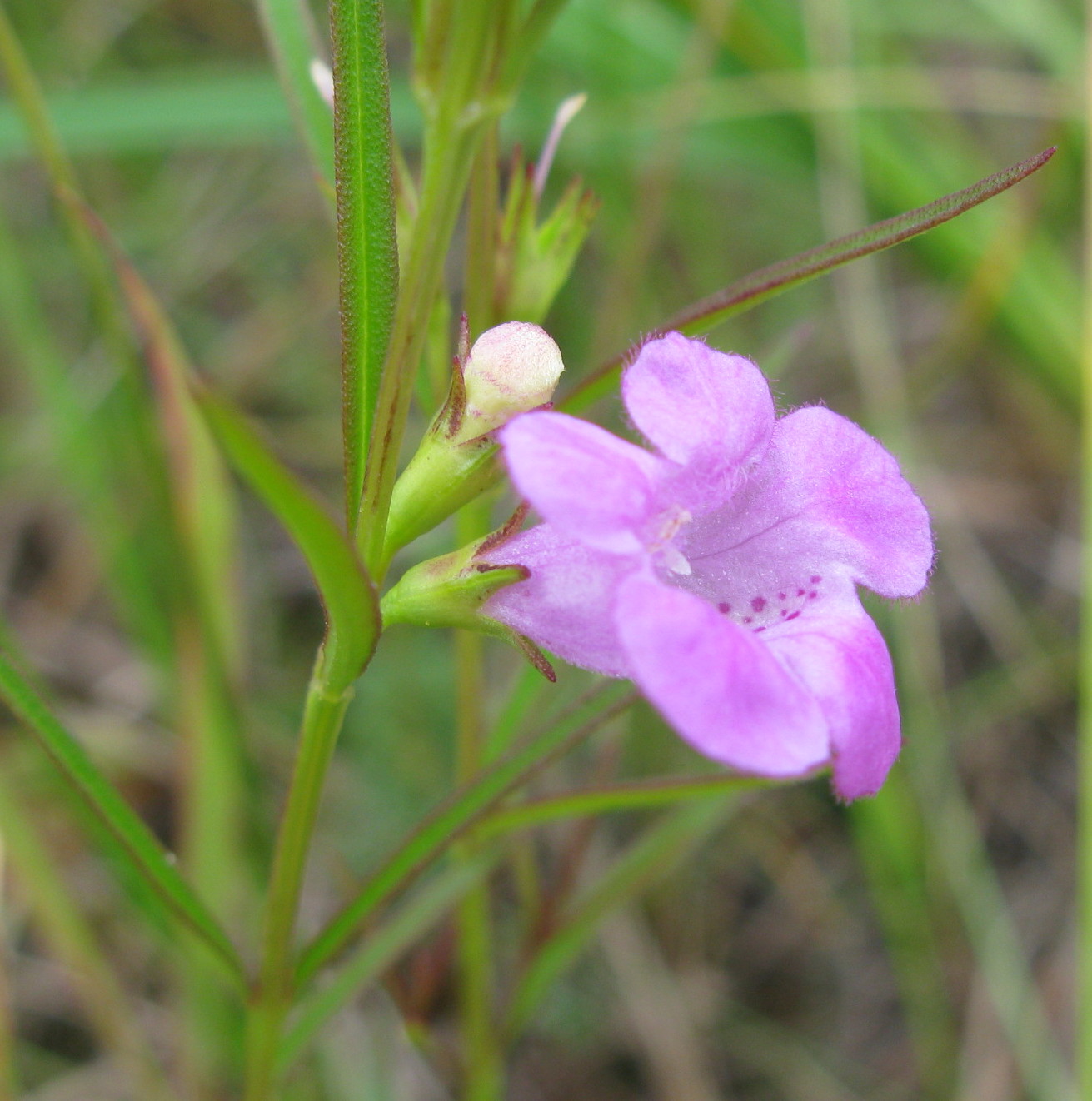Purple false foxglove
(Agalinis pulchella)

Description
Agalinis pulchella, commonly known as the showy agalinis or purple false foxglove, is a captivating flowering plant that belongs to the family Orobanchaceae. This herbaceous perennial is renowned for its striking purple blossoms and delicate foliage. Native to North America, Agalinis pulchella can be found in various habitats, ranging from open woodlands to prairies and meadows. With its alluring charm and ecological significance, this species has captured the attention of plant enthusiasts and conservationists alike. In this article, we delve into the world of Agalinis pulchella, exploring its morphology, habitat, lifecycle, ecological interactions, and conservation status. Morphology Agalinis pulchella possesses a slender and erect stem, which can grow up to 2 feet (60 cm) in height. The stem is characterized by its light green color and is often branched towards the upper sections. The lanceolate leaves of this species are oppositely arranged along the stem, with each leaf measuring around 1 to 2 inches (2.5 to 5 cm) in length. The leaves are typically smooth, with a glossy surface, and have entire or slightly toothed margins. The showy agalinis produces vibrant, tubular flowers that emerge from the leaf axils, forming loose clusters at the top of the stem. These striking flowers exhibit a range of shades, including deep purple, lavender, and occasionally pink. Each flower measures approximately 1 inch (2.5 cm) in length and features a bilaterally symmetrical corolla with five lobes. The lower lobe acts as a landing platform for visiting pollinators, while the upper lobes form a hood-like structure. The showy agalinis blooms from mid-summer through early autumn, adding a splash of color to the landscape. Habitat and Distribution Agalinis pulchella is native to North America and can be found throughout the United States and parts of Canada. This species thrives in a diverse range of habitats, including dry prairies, open woodlands, meadows, and sandy or rocky areas. It is commonly encountered in disturbed sites such as roadsides and railroad tracks, where its growth is facilitated by sunlight and reduced competition from other plants. Lifecycle and Reproduction As a perennial plant, Agalinis pulchella establishes a robust root system that allows it to survive and persist for multiple growing seasons. During the winter months, the aerial parts of the plant die back, while energy is stored in the underground structures. In spring, as temperatures rise, new shoots emerge from the root system, initiating a new growth cycle. The showy agalinis primarily reproduces through seeds. Following pollination, the flowers give way to small, dry capsules containing numerous tiny seeds. These capsules are dehiscent, meaning they split open when mature, facilitating seed dispersal. The seeds are lightweight and can be dispersed by wind, adhering to passing animals or humans, or by water in wetland habitats. Once dispersed, the seeds can lie dormant in the soil for extended periods until conditions are favorable for germination. Ecological Interactions Agalinis pulchella plays a vital role in the ecosystem, particularly in supporting pollinators. The tubular flowers of this plant, with their nectar-rich rewards, attract a diverse array of pollinators, including bees, butterflies, and hummingbirds. These visitors are essential for cross-pollination, facilitating genetic diversity within the species and promoting the health of the population. Additionally, Agalinis pulchella serves as a host plant for various butterfly species, including the larvae of the endangered Karner blue butterfly (Plebejus melissa samuelis). The larvae of the Karner blue butterfly feed exclusively on the leaves of Agalinis pulchella, making this plant crucial for the survival of the butterfly population. The specialized relationship between the showy agalinis and the Karner blue butterfly highlights the interconnectedness of species within ecosystems and underscores the importance of preserving habitat and maintaining plant diversity. Conservation Status Agalinis pulchella faces several challenges that have led to its decline in certain regions. Habitat loss and degradation, resulting from urbanization, agriculture, and land development, pose significant threats to the species. The conversion of natural habitats into fragmented landscapes reduces the availability of suitable areas for Agalinis pulchella to grow and reproduce. Furthermore, the showy agalinis is often outcompeted by aggressive non-native plant species, which can displace and suppress its growth. These invasive plants, with their rapid spread and competitive advantage, can alter the composition of plant communities, negatively impacting native species like Agalinis pulchella. Given these threats, efforts are underway to conserve and protect Agalinis pulchella and its habitat. Conservation organizations and land management agencies are working to identify and preserve critical habitats, implement restoration projects, and control the spread of invasive species. Additionally, raising public awareness about the ecological importance of Agalinis pulchella and promoting its cultivation in home gardens can contribute to its conservation. Conclusion Agalinis pulchella, the showy agalinis or purple false foxglove, is a captivating perennial plant native to North America. Its slender stems, lanceolate leaves, and vibrant purple flowers make it a visually stunning addition to the floral kingdom. Thriving in a range of habitats, this plant plays a vital role in supporting pollinators and serves as a host for the endangered Karner blue butterfly. However, Agalinis pulchella faces significant challenges, including habitat loss, invasive species competition, and fragmentation of landscapes. Conservation efforts aimed at preserving its habitat, controlling invasive species, and raising public awareness are crucial for the long-term survival of this species. By understanding and appreciating the ecological significance of Agalinis pulchella, we can contribute to its conservation and ensure that future generations can continue to enjoy the delicate beauty it brings to our natural landscapes.
Taxonomic tree:







